The ’80s ruined faux. The decade that gave us big hair and acid-washed jeans also introduced sponge-painting and marbleizing kits to the masses. Suddenly, amateurs started taking a Renaissance-era art technique and applying it to everything from stereo cabinets to strip-mall restaurant walls. The result? "There’s a lot of cheese out there," says Stephanie Gabel, owner of the decorative painting firm Roux Design (773-227-0104; rouxdesign.net). Which is exactly what she and our other experts will help you avoid.
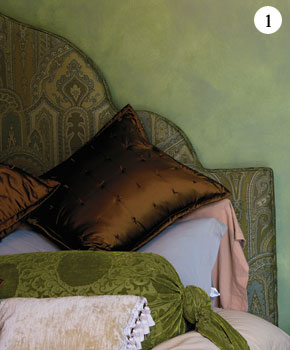 |
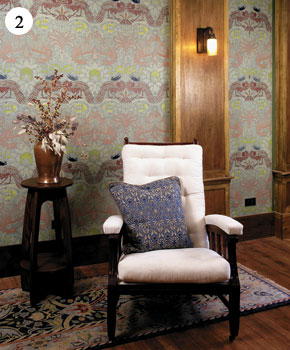 |
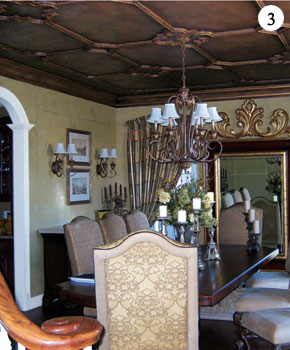 |
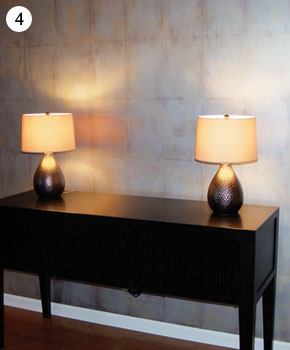 |
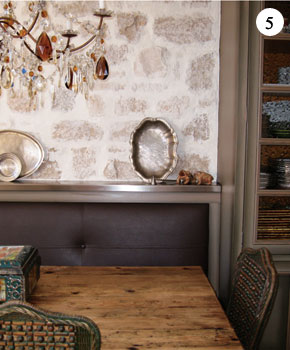 |
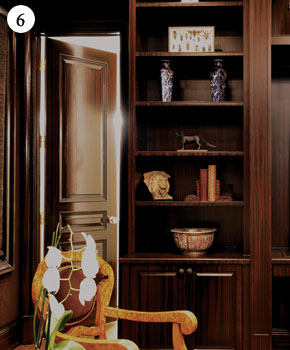 |
1) Glazing by DesignRed adds a luxe touch to a bedroom 2) Stenciling by DesignRed is like seamless wallpaper 3) A ceiling gets a lift with a glaze by Roux Design 4) Metallic paint by Faux Design Studio enlivens an entryway 5) Simes Studios’ faux-distressed wood cabinets and limestone finish over a real stone wall gives this kitchen a rich, rustic look 6) Faux bois by DesignRed buys the wood look for less
DO Use faux to solve otherwise expensive design problems. Cindy Simes, a decorative painter who co-owns Simes Studios (773-327-7101; simesstudios.com) with her husband, Jorge, had a client who wanted to redo her mediocre-quality-wood library. "She was like, ‘I need to rip the whole room out, and I just can’t do it,’" Cindy recalls. Instead, Simes Studios gave the walls, bookshelves, and fireplace mantel a faux knotty pine finish, averting the need for a messy, expensive gut job. Another Simes client wanted to replace wood moldings with stone, which would have been heavy and tricky to install; faux stone moldings were much less expensive.
DO Get the wallpaper look without compromising on a thing. Sure, you can get a damask patterned wallpaper, but if the pattern doesn’t come in the colors you want, or it’s not quite the scale you had in mind, then what are you going to do? Hire a faux painter to stencil a design on your wall to your exact specifications. "It may cost you more, but you’ll get exactly what you want," says Bill Borman of DesignRed (847-736-0733; designred.biz).
DO Use a faux grass-cloth treatment to add texture and subtle color to a neutral-toned room that might otherwise feel boring. Not only will it likely cost you less than cloth wallpaper, you won’t have any of those unseemly seams.
DO Disguise flaws in old plaster walls but retain their worn-with-age charm with soft expanses of colorwashing. "Think of it as controlled aging," says Jorge Simes, referring to that just-right amount of natural patina in a historic building that, in the hands of a faux painter, can "remain at that beautiful stage forever."
DON’T Assume that faux finishes are only for traditional homes. They can also work well in modern settings. One of Gabel’s clients, who lived in a downtown high-rise, "had just an unbelievable art collection-Warhols, Rauschenbergs," she recalls. He didn’t want to hang his masterpieces against flat, chalky white walls, but the walls couldn’t compete with the artwork either. "We did a very creamy Venetian plaster," she says. "It was warm, but it didn’t take away from the art."
DON’T Put metallic finishes in bathrooms that get a lot of use. While faux finishes can be as durable and washable as wallpaper-making them suitable for most rooms in the house-too much moisture can oxidize and alter the color.
DON’T Ignore what’s going on in adjacent rooms. "If the dining room has a deep red glaze, you don’t want the rooms right next to it to have a [dramatic] faux finish," says Cindy Simes. She might opt for a metallic finish that’s soft, subtle, and atmospheric in one room. In the next, she’ll use a more striking effect on a ceiling, focal wall, or niche.
DON’T Get overconfident about doing projects-especially big ones-yourself. "Just taking a one-hour class is not enough," says Sheri Zeman, owner of Faux Design Studio (630-627-1011; fauxdesignstudio.com), a training center and decorative paint retailer in Addison. "It’s a skilled art form, and you can’t expect professional results by going to a home improvement store and carrying home plaster an hour later."
Photography: (Design Red) Richard Thomas, (Simes Studios) Facundo de Zuviria, (roux design) Stephanie gabel, (Faux Design Studio) Robert Mauer, (glazing) Facundo de zuviria, (gilding) richard thomas, (plasters) courtesy faux design studio
When Hiring a Pro…
Always look at samples of the artist’s work, paying particular attention to color and technique. Poor color choices are one of the hallmarks of bad faux. "They’re too deep or they’re too far apart, like a yellow wall with green, or a taupe wall with pink or blue coming through," says Borman. "The colors are just garish."
Watch out for sloppy execution. "Look in the corners, at the tops of walls along the ceiling, at the bottom along the baseboards," Gabel says. The finish should extend all the way to the edges. The color shouldn’t be broken anywhere, nor should you be able to see overlapping edges of colors. Avoid work that looks gloppy or heavy-handed; subtlety is key.
Be realistic about price. The cost of a faux finish depends almost entirely on the amount of labor involved. The most affordable finishes involve just one pass around a room; striae, for instance, might run around six or seven dollars per square foot. A bigger budget is needed for more complicated techniques: linen glazing, two-coat metallic glazes, certain plaster finishes. The most expensive finishes include faux bois (fake wood graining), which involves making rough outlines, then filling them in with layers of glaze, and leafing, which is a delicate, time-consuming process.
Take your time. You don’t have to have every surface of your house done at once. The durability of high-quality faux finishes means you can start with one and add more later. "Pick a focal point and build on it little by little, the way you would with furniture," Simes recommends.
The Lingo
Good decorative painters constantly combine and play with different finishes to create their own spins on standard techniques. Still, there are several categories into which most finishes fall.
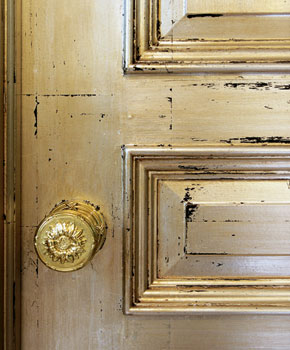 |
Glazing
Glazing is the broadest, encompassing dozens of techniques. What they all have in common is the application of layers of translucent color that are then manipulated in some way. Among the types of glazing:
• Striae: pulling glaze vertically or horizontally to create a lined effect, like grass cloth
• Linen or chambray: doing striae in both a vertical and a horizontal direction, giving the look of woven fabric
• Color washing: applying glaze to a surface with a sponge or cloth to create softly mottled color
• Antiquing: distressing a glazed finish to make it look old
• Marbleizing: creating the look of marble
• Faux bois: mimicking the appearance of wood grain
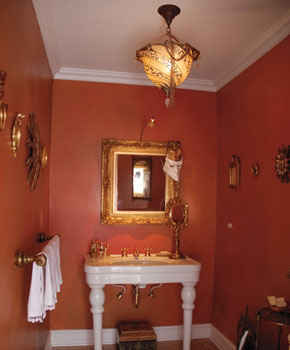 |
Gilding
Gilding involves applying ultra-thin layers of metal leafing, typically gold or silver, to a surface. A less lustrous but also less expensive effect can be achieved by using metallic paints or metallic powders mixed with paint; pale champagne metallics are especially hot right now.
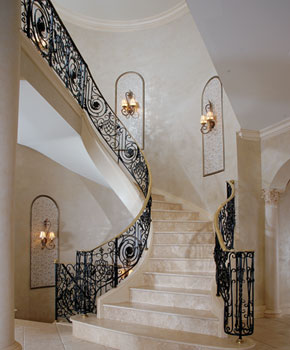 |
Plasters
Plasters involve applying layers of plaster with a trowel or knife, with an effect ranging from chunky to smooth. Shiny Venetian plasters, created with thin layers and burnished to look like polished stone, have become extremely popular.
Photography: (Design Red) Richard Thomas, (Simes Studios) Facundo de Zuviria, (roux design) Stephanie gabel, (Faux Design Studio) Robert Mauer, (glazing) Facundo de zuviria, (gilding) richard thomas, (plasters) courtesy faux design studio


